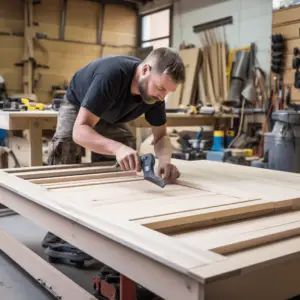When it’s time to move the bed to another house or another room, knowing how to take apart the bed frame is vital. The only tools you need to dismantle a typical bed include; a screwdriver, a hammer, and sometimes pliers. But how do you take apart a wooden bed frame with no screws?
These bed frames seem to have slot joint systems which are just hard to figure out how to take them apart. Others have pegs that would probably allow you to slide the side out, but even for more experienced DIYers, the entire process can be a little bit more involving to tackle.
Table of Contents
How to Dismantle a Wooden Bed Frame with No Screws

Before you jump into taking apart a bed frame, you first need to remove all pillows and bedding from the bed. Completely strip the bed linen and other items that could keep you from accomplishing the job effectively and on time.
Remove the Mattress and Base
Most beds have five parts: the headboard, bed frame, bed foundation, and footboard, but the mattress is the most crucial and expensive. Thus, transporting a bed frame entails removing the mattress and foundation.
This will make the process of dismantling the headboard and footboard from the main bed frame far easier. Wrap the mattress properly and then follow this step-by-step guide on how to take apart a wooden bed frame with no screws.
Disassembling the Rails
Some beds have slots that indicate a possibility of dissembling the bed with no need to remove the bolts. So try lifting the rail and then moving the head/foot away from the rail. You don’t necessarily have to take the bolts or pins out.
Rails in these types of beds typically have a thin metal bracket that is inserted into the head or footboards. All you need to do is to slip onto the pins, pull the headboard/footboard and it should come apart.
You may also want to try lifting the frame. Depending on how much it’s been made, hitting in a direction opposed to gravity might be helpful. This is where a hammer may come in handy. You often have to give the rail a sharp upward hammer blow near the connection point to loosen the hooks.
Once the rail loosens, it should come off the pins easily. Note that some rails are connected with bolts; in that case, you will have to use a wrench to loosen the bolts and remove them. Disassemble both the rails from either headboard or footboard before dismantling them from the other head.
Simply put, it seems like bed frame rails go into the headboard and footboard. They either lift up to release or the rail has to be knocked out to release those pins.
Moreover, the side of the frame rail outside of the bed should give a hint if they remove by pounding out. So if the solid wood looks clean with no pinhole, then the rails will have to be knocked up to release from the headboard and footboard.
Wrap the Bed Frame in the Correct Material
The correct way to wrap footboards and headboards depends on their material. This is crucial if you wish to move the bed to another room or residence.
Even after disassembling the bed frame, all parts should be wrapped in bubble wrap to prevent dings, scratches, and dents during transit.
Instead of plastic, wrap the hardwood bed frame with moving blankets. Due to its restricting nature, plastic may damage wood surfaces. Before adding bubble wrap for further protection, wrap the wooden frame in blankets.
How to Stop a Wooden Bed Frame from Squeaking

There are various ways to do away with bed frame noise. The first thing is to determine where the noise is coming from. Check the frame for broken slats and make sure all pins, bolts, and screws areate tightly fastened. Then use oil to lubricate the bolts and screws. Also, consider adding plastic washers.
You can also reduce friction by applying wax to problematic areas using cork to plug gaps or insert raisers under the legs. Keep the wooden bed away from water and heat sources to protect it against unnecessary swelling.’
Pros and Cons of Wooden Bed Frames
One of the most impressive things about wooden frames is style options. Wooden frames are available in a variety of wood types, finishes, designs, colors, and constructions to match just about any shopper’s style needs- although most people like the look of the wood’s natural grain.
Another major highlight is durability. With proper care and maintenance, a high-quality wooden bed frame can have a long lifespan. Natural wooden frames are also biodegradable. That means they can be without chemicals- although applying certain types of adhesives, stains, and vanishes might compromise these environmental benefits.
On the flip side, however, natural wooden bed frames may be vulnerable to certain types of damage. They are also associated with higher price-point compared to other options such as metal bed frames due to the higher cost of materials and construction.
Weight is yet another major concern, while some wood bed frames are relatively lightweight, others are incredibly heavy and may be challenging to assemble or move around.
Moreover, unlike metal frames, wooden bed frames are prone to damage from heat, humidity, and even pests. They generally require more attention than metal bed frames, and thus they may need to be repaired or replaced quite often.
